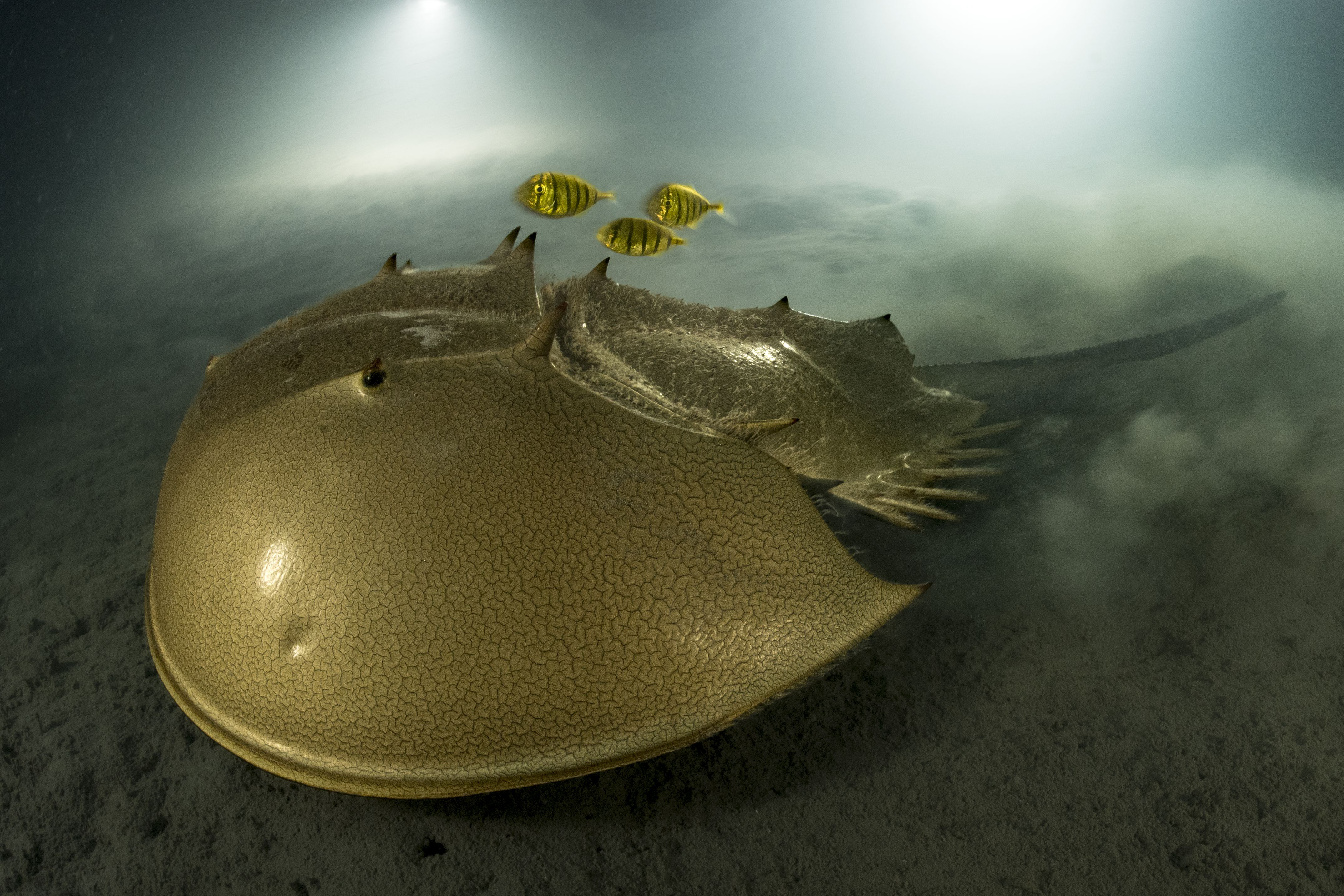The 59th Wildlife Photographer of the Year competition welcomed 49,957 entries from 95 countries. French underwater photographer and marine biologist Laurent Ballesta’s image titled The Golden Horseshoe won him the Adult Grand Title Winner 2023 for the second time. Ballesta won the same prize in 2021. The tri-spine horseshoe crab faces extinction from overfishing, and it is wanted for its blue blood, used in the development of vaccines.
Chair of the jury Kathy Moran says: “To see a horseshoe crab so vibrantly alive in its natural habitat, in such a hauntingly beautiful way, was astonishing. We are looking at an ancient species, highly endangered, and also critical to human health. This photo is luminescent.”
The exhibition showcasing these images is being shown at the Natural History Museum in London until 30 June. The entry fees for photographers in Africa, Southeast Asia and Central and South America have been waived to encourage more entries from these regions.
 Jasper Doest (the Netherlands) shows the final moments of extreme distress felt by an elephant hit by a train transporting manganese between the southern town of Moanda and Gabon’s capital Libreville. The collision shattered the elephant’s hip beyond repair. (Photo: © Jasper Doest / Wildlife Photographer of the Year)
Jasper Doest (the Netherlands) shows the final moments of extreme distress felt by an elephant hit by a train transporting manganese between the southern town of Moanda and Gabon’s capital Libreville. The collision shattered the elephant’s hip beyond repair. (Photo: © Jasper Doest / Wildlife Photographer of the Year)
 Piotr Naskrecki (Poland/US) illustrates the cyclical nature of life on the African savannah. Naskrecki had tried for many years to use his drone to witness the drama of the ending of a dry season in Gorongosa, Mozambique. Here, he stumbled upon a water buck that had died after becoming stuck in the mud. While African sharptooth catfish waited for the rains to come, some scavenged meat from its carcass. Sharptooth catfish are omnivorous and can survive for several days out of the water thanks to an air-breathing organ in their gills. (Photo: © Piotr Naskrecki /Wildlife Photographer of the Year)
Piotr Naskrecki (Poland/US) illustrates the cyclical nature of life on the African savannah. Naskrecki had tried for many years to use his drone to witness the drama of the ending of a dry season in Gorongosa, Mozambique. Here, he stumbled upon a water buck that had died after becoming stuck in the mud. While African sharptooth catfish waited for the rains to come, some scavenged meat from its carcass. Sharptooth catfish are omnivorous and can survive for several days out of the water thanks to an air-breathing organ in their gills. (Photo: © Piotr Naskrecki /Wildlife Photographer of the Year)
 Max Waugh (US) catches sight of a plains bison kicking up flurries of snow over its bulky frame in Yellowstone National Park, US. Bison herds move in single file as they search for food, making for a striking sight. Plains bison eat mainly grasses and sedges, sweeping their bulky heads from side to side to clear the snow with their muzzles. Males can reach almost 4m long and 2m high at the shoulder. (Photo: © Max Waugh / Wildlife Photographer of the Year)
Max Waugh (US) catches sight of a plains bison kicking up flurries of snow over its bulky frame in Yellowstone National Park, US. Bison herds move in single file as they search for food, making for a striking sight. Plains bison eat mainly grasses and sedges, sweeping their bulky heads from side to side to clear the snow with their muzzles. Males can reach almost 4m long and 2m high at the shoulder. (Photo: © Max Waugh / Wildlife Photographer of the Year)
 Ismael Domínguez Gutiérrez (Spain) uses the strobe mode on his camera to capture the gymnastic flight path of a bat against a backdrop of stars. (Photo: © Ismael Domínguez Gutiérrez / Wildlife Photographer of the Year)
Ismael Domínguez Gutiérrez (Spain) uses the strobe mode on his camera to capture the gymnastic flight path of a bat against a backdrop of stars. (Photo: © Ismael Domínguez Gutiérrez / Wildlife Photographer of the Year)
 Pietro Formis (Italy) discovers a Mediterranean stargazer peering through the sandy coastal waters. Formis approached the stargazer with care so as not to disturb it. (Photo: © Pietro Formis / Wildlife Photographer of the Year)
Pietro Formis (Italy) discovers a Mediterranean stargazer peering through the sandy coastal waters. Formis approached the stargazer with care so as not to disturb it. (Photo: © Pietro Formis / Wildlife Photographer of the Year)
 Lennart Verheuvel (the Netherlands) records a beached orca’s final moments. Lying on its side in the surf, this orca had only a short time left to live. (Photo: © Lennart Verheuvel / Wildlife Photographer of the Year)
Lennart Verheuvel (the Netherlands) records a beached orca’s final moments. Lying on its side in the surf, this orca had only a short time left to live. (Photo: © Lennart Verheuvel / Wildlife Photographer of the Year)
 Tom Way (UK) watches the clash of two Komodo dragons through clouds of golden sand. ‘I felt like it was almost a snapshot back to a bygone age,’ says Way. (Photo: © Tom Way / Wildlife Photographer of the Year)
Tom Way (UK) watches the clash of two Komodo dragons through clouds of golden sand. ‘I felt like it was almost a snapshot back to a bygone age,’ says Way. (Photo: © Tom Way / Wildlife Photographer of the Year)
 Knut-Sverre Horn (Norway) offers a glimpse of kittiwake chicks in an abandoned factory. As midnight approached, the low summer sun struck the window, giving him the image. (Photo: © Knut Sverre Horn / Wildlife Photographer of the Year)
Knut-Sverre Horn (Norway) offers a glimpse of kittiwake chicks in an abandoned factory. As midnight approached, the low summer sun struck the window, giving him the image. (Photo: © Knut Sverre Horn / Wildlife Photographer of the Year)
 Adrienn Vincze (Hungary) highlights an intricate window imprint left behind by a pigeon. Placing black card over the feather dust on the outside of the pane, she used natural light to transform the imprint into a starry universe. (Photo: © Adrienn Vincze / Wildlife Photographer of the Year)
Adrienn Vincze (Hungary) highlights an intricate window imprint left behind by a pigeon. Placing black card over the feather dust on the outside of the pane, she used natural light to transform the imprint into a starry universe. (Photo: © Adrienn Vincze / Wildlife Photographer of the Year)
 Bruno D’Amicis (Italy) is rewarded for his perseverance with a mosaic-like image of a Mediterranean monk seal. Beneath the cliff top where D’Amicis lay hidden, a Mediterranean monk seal glided through the shallows before disappearing into a cave. Masked by the reflections on the water, the seal appears to be almost vanishing in front of our eyes – an apt metaphor given that the species is on the brink of extinction. (Photo: © Bruno DAmicis / Wildlife Photographer of the Year)
Bruno D’Amicis (Italy) is rewarded for his perseverance with a mosaic-like image of a Mediterranean monk seal. Beneath the cliff top where D’Amicis lay hidden, a Mediterranean monk seal glided through the shallows before disappearing into a cave. Masked by the reflections on the water, the seal appears to be almost vanishing in front of our eyes – an apt metaphor given that the species is on the brink of extinction. (Photo: © Bruno DAmicis / Wildlife Photographer of the Year)
 Bertie Gregory (UK) tracks a pod of orcas as they prepare to wave wash a Weddell seal. These pack ice orcas are identified by their characteristically large white eye patches. To spot a seal at rest on an ice floe, the orcas spyhop by poking their heads above the surface. They then charge towards the ice, creating a large wave that washes the seal into the water where it has little chance of escape. (Photo: © Bertie Gregory / Wildlife Photographer of the Year)
Bertie Gregory (UK) tracks a pod of orcas as they prepare to wave wash a Weddell seal. These pack ice orcas are identified by their characteristically large white eye patches. To spot a seal at rest on an ice floe, the orcas spyhop by poking their heads above the surface. They then charge towards the ice, creating a large wave that washes the seal into the water where it has little chance of escape. (Photo: © Bertie Gregory / Wildlife Photographer of the Year)
DM
This story first appeared in our weekly Daily Maverick 168 newspaper, which is available countrywide for R29.





 Bertie Gregory (UK) tracks a pod of orcas as they prepare to wave wash a Weddell seal. These pack ice orcas are identified by their characteristically large white eye patches. To spot a seal at rest on an ice floe, the orcas spyhop by poking their heads above the surface. They then charge towards the ice, creating a large wave that washes the seal into the water where it has little chance of escape. (Photo: © Bertie Gregory / Wildlife Photographer of the Year)
Bertie Gregory (UK) tracks a pod of orcas as they prepare to wave wash a Weddell seal. These pack ice orcas are identified by their characteristically large white eye patches. To spot a seal at rest on an ice floe, the orcas spyhop by poking their heads above the surface. They then charge towards the ice, creating a large wave that washes the seal into the water where it has little chance of escape. (Photo: © Bertie Gregory / Wildlife Photographer of the Year)